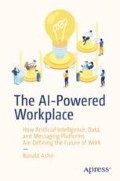Abstract
How does one even start to capture the processes that lead to what we recognize as “intelligent” behavior? More appropriately for our definition of AI, how does one begin to program machines so that they can make decisions instead of us?
Access this chapter
Tax calculation will be finalised at checkout
Purchases are for personal use only
Notes
- 1.
In recent years, especially after Google launched what it calls its Knowledge Graph, people started referring to various forms of ontologies as knowledge graphs. The Google Knowledge Graph is what powers the answers you get to the side of Google search results in a standout box. Following an analysis of your query, if they are able to pinpoint a specific reply to your question (as opposed to a search result) they will provide that. Since then, the term knowledge graph has been creeping into literature, and you might find ontology mentioned in more formal settings and knowledge graphs elsewhere. Ultimately, it all points to the same end result: a structured representation of information that machines can reason over.
- 2.
Please note that I am simplifying here considerably. Typically, for text classification word frequencies are the key feature, and the way you represent these frequencies (as mathematical vectors rather than actual text or sums) is quite sophisticated and is a field of study within natural language processing in and of its own accord.
- 3.
David Silver et al., “Mastering the game of Go with deep neural networks and tree search” Nature 2016, 529: 484-489.
- 4.
I placed the word neurons in quotes because it is important to remember that these artificial neurons have very little to do with how neurons in our brain work. While brain neurons may have been the source of inspiration for artificial neurons, we now know enough about how the brain works to at least be absolutely sure that the functioning of ANNs bears little resemblance to the functioning of the brain.
Author information
Authors and Affiliations
Rights and permissions
Copyright information
© 2020 Ronald Ashri
About this chapter
Cite this chapter
Ashri, R. (2020). Core AI Techniques. In: The AI-Powered Workplace. Apress, Berkeley, CA. https://doi.org/10.1007/978-1-4842-5476-9_4
Download citation
DOI: https://doi.org/10.1007/978-1-4842-5476-9_4
Published:
Publisher Name: Apress, Berkeley, CA
Print ISBN: 978-1-4842-5475-2
Online ISBN: 978-1-4842-5476-9
eBook Packages: Professional and Applied ComputingApress Access BooksProfessional and Applied Computing (R0)

